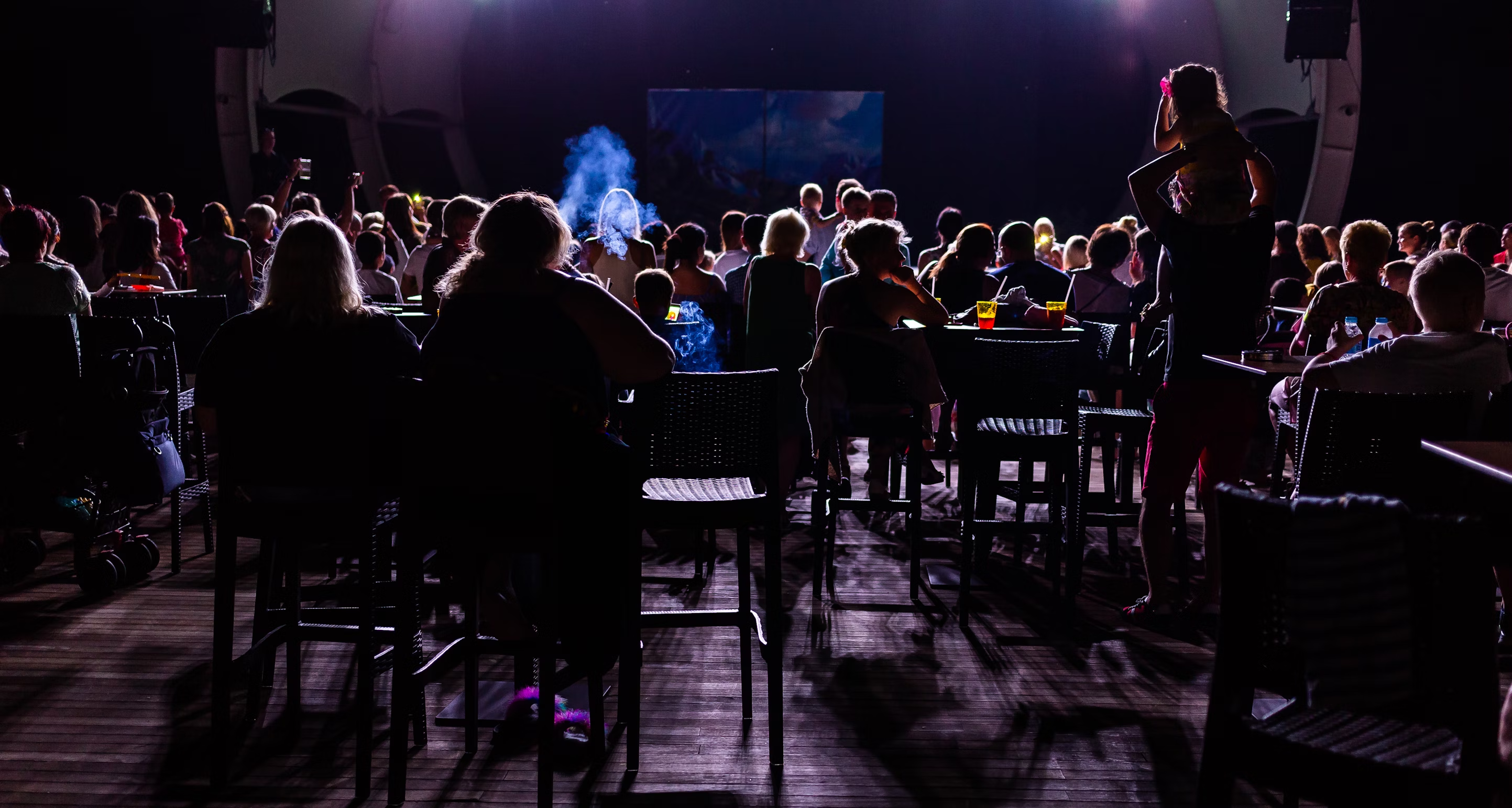Introduction: The Power of Multilingualism on Stage
The art of theatre has the potential to transcend linguistic barriers and foster a deeper understanding among diverse audiences. Multilingualism in theatre productions refers to the intentional incorporation of multiple languages within a single performance, reflecting the rich tapestry of cultures and identities that coexist in our societies.
The significance of multilingual theatre lies in its ability to challenge traditional notions of linguistic hegemony and embrace the complexities of human experience. By weaving together different tongues, playwrights and directors can create authentic narratives that resonate with audiences from various backgrounds, allowing them to see themselves represented on stage. According to research, multilingual theatre not only promotes cultural awareness but also serves as a powerful tool for social change, raising awareness of pressing issues and fostering empathy among diverse communities.
At its core, multilingual theatre is a celebration of linguistic diversity, inviting audiences to immerse themselves in a rich tapestry of languages, each with its own unique cadence, rhythm, and cultural nuances. By embracing this linguistic plurality, theatre productions can transcend boundaries, forge connections, and ultimately contribute to a more inclusive and understanding society.
Breaking Language Barriers: Reaching a Diverse Audience
Multilingual theatre productions have the power to transcend language barriers, allowing artists to connect with diverse audiences and foster a sense of inclusivity. By incorporating multiple languages into a single performance, theatre companies can attract and engage a broader range of spectators, reflecting the rich cultural tapestry of their communities.
One of the primary benefits of multilingual theatre is its ability to resonate with audiences from various linguistic backgrounds. As Garles (2011) notes, "The audience is still being exposed to the use of foreign language(s), and language then becomes a theatrical convention instead of a simply artistic element." This exposure not only enriches the theatrical experience but also celebrates linguistic diversity, making audiences feel seen and represented.
Moreover, multilingual productions can serve as a bridge between cultures, fostering understanding and appreciation for different traditions and perspectives. The Jeune Théâtre Européen Jeunes Publics Project demonstrates how "multilingual theatre for young audiences creates spaces for young people from diverse backgrounds to see that in their home languages and cultures, they have a place on stage." By embracing linguistic diversity, theatre companies can cultivate a sense of belonging and validation for underrepresented communities.
Authenticity and Cultural Representation
Multilingualism on stage is a powerful tool for enhancing the authenticity of cultural representations. By embracing the linguistic diversity present in many communities, theatre productions can more accurately depict the lived experiences and identities of the characters and stories they portray.
The use of multiple languages in a play serves as a mechanism for factuality, authenticating each character's linguistic and cultural identity. By allowing characters to express themselves in their native tongues, multilingual productions can more accurately capture the nuances and complexities of their experiences, perspectives, and backgrounds.
Moreover, embracing linguistic diversity on stage is a powerful way to respect and celebrate the richness of different cultures. As highlighted in the article "AAVE in Theatre: Embracing Authentic Expression", incorporating language varieties like African American Vernacular English (AAVE) in theatrical works allows for the representation of diverse voices and the authentic expression of cultural identities.
By incorporating multilingualism into theatre productions, directors, playwrights, and dramaturgs can create more nuanced, authentic, and culturally resonant works that honor the linguistic diversity of their communities and audiences.

Casting Considerations
Casting is a crucial aspect of bringing multilingual theatre productions to life. Directors and producers must consider various factors to ensure authentic representation and effective storytelling. One strategy is to prioritize actors who are native speakers or fluent in the languages required for the production. This approach lends credibility and nuance to the performances.
However, finding multilingual actors can be a challenge, especially for lesser-known languages or specific dialect requirements. In such cases, directors may need to be flexible and provide language coaching or consider dubbing or subtitling options. It's also important to be mindful of cultural appropriation and avoid stereotyping or perpetuating harmful tropes.
Inclusive casting practices should be embraced, allowing actors of diverse backgrounds and experiences to audition for roles that may not traditionally align with their ethnicity or language. This approach not only broadens the talent pool but also promotes authentic representation and fosters a more inclusive theatre community.
Collaborating with language consultants, cultural advisors, and community organizations can aid in the casting process and ensure respectful and accurate portrayals. Additionally, creating a supportive and inclusive rehearsal environment is crucial for multilingual casts to thrive and feel comfortable exploring the nuances of their roles.
Ultimately, casting multilingual productions requires open-mindedness, creativity, and a commitment to authentic representation. By embracing diversity and fostering an inclusive environment, theatre companies can create rich and resonant experiences that celebrate the beauty of linguistic diversity on stage.
Directing and Rehearsing Multilingual Productions
Directing a multilingual production requires careful planning, open communication, and a collaborative approach. One of the primary challenges is ensuring that all actors, regardless of their language proficiency, feel included and supported throughout the rehearsal process. Establishing a common working language from the outset can facilitate clear communication and avoid misunderstandings.
It is recommended to provide language coaching and resources to actors who may be working in a language they are less fluent in. This not only helps with accurate pronunciation and delivery but also fosters a deeper understanding of the cultural nuances and context of the language.
Incorporating multilingual warm-up exercises and games can create a playful and inclusive environment, encouraging actors to embrace the linguistic diversity of the production. Patience and flexibility are essential, as rehearsals may require more time to accommodate translation and ensure everyone is on the same page.
Collaboration with a multilingual dramaturg or language consultant can be invaluable, providing insights into cultural references, idioms, and linguistic subtleties that might be lost in translation. Their expertise can help bridge gaps and ensure the authenticity of the multilingual experience for both the actors and the audience.
Translating and Adapting Scripts
Translating and adapting scripts is a crucial step in creating multilingual theatre productions. It requires a delicate balance between preserving the original intent and essence of the work while making it accessible to diverse audiences. Best practices in this process include:
- Collaborating closely with the playwright or original author to ensure the translation remains faithful to the source material. As highlighted in the chapter "Translating for the Theatre", theatre provides many illustrations of multiple translations of classic texts, and ancient tragedy in English translation maintains a strong presence on stages worldwide.
- Adapting the script to suit the cultural context and nuances of the target audience. This may involve adjusting idioms, references, and humor to ensure they resonate with the new audience.
- Considering the performative aspects of the script, such as rhythm, pacing, and stage directions, to ensure the translated version maintains its theatrical quality.
- Involving native speakers and language experts in the translation and adaptation process to ensure accuracy and authenticity.
- Conducting read-throughs and workshops with the translated script to identify potential issues or areas that may require further refinement.
By following these best practices, theatre companies can create multilingual productions that not only entertain but also promote cultural understanding and appreciation for linguistic diversity.
Surtitles and Captioning
Surtitles and captioning play a crucial role in making theatre productions accessible to multilingual audiences. These visual aids provide translations or transcriptions of the spoken dialogue, enabling audience members who may not understand the language(s) used on stage to follow the performance.
Surtitles, also known as supertitles, are projected translations displayed above or near the stage. They are commonly used in opera and foreign language productions, presenting concise translations in sync with the spoken dialogue. According to Bellingua Translations, creating surtitles involves formatting the script to limit the number of characters per line and removing stage directions.
Captioning, on the other hand, involves displaying a verbatim transcription of the dialogue, sound effects, and other auditory elements. This method is particularly beneficial for audiences with hearing impairments or those unfamiliar with the language(s) used in the production. As mentioned in a Reddit discussion, some theatres employ external captioners and rig screens in the auditorium for each captioned performance.
Implementing surtitles and captioning requires careful planning and coordination between the creative team, technical crew, and translation/captioning services. Considerations include screen placement, font size and legibility, synchronization with the performance, and ensuring the translations accurately convey the intended meaning and nuances of the original text.
Promoting and Marketing Multilingual Productions
Promoting and marketing multilingual productions requires a strategic approach to reach diverse audiences effectively. One effective strategy is to leverage digital platforms and social media channels to showcase the linguistic diversity of the production. Creating engaging content, such as behind-the-scenes videos, interviews with multilingual cast members, and snippets of rehearsals, can pique interest and highlight the unique aspects of the production.
Collaborating with influencers and ambassadors from various linguistic backgrounds can also be a powerful tool for reaching new audiences. Their authentic voices and connections within their communities can lend credibility and generate excitement around the multilingual production.
Case Studies: Successful Multilingual Productions
One notable example of a successful multilingual theatre production is the English-Spanish adaptation of "Life is a Dream" by Pedro Calderón de la Barca, staged by the Repertorio Español company in New York City. By presenting the play in both languages simultaneously, with English and Spanish subtitles, the production allowed audiences from diverse linguistic backgrounds to appreciate the classic Spanish drama. The bilingual approach not only promoted cultural exchange but also attracted new audiences to experience the richness of Hispanic theatre.
Another groundbreaking multilingual production was the Stratford Festival's "The Breathing Hole" by Colleen Murphy, performed in English, French, Cantonese, and the Indigenous language of Southern East Cree. By incorporating multiple languages, the play authentically represented the diverse communities it portrayed and facilitated a deeper understanding of the characters' experiences. The production's innovative use of surtitles and creative staging ensured that audiences could follow the narrative seamlessly, regardless of their linguistic backgrounds.
These examples demonstrate how multilingual theatre productions can not only celebrate linguistic diversity but also foster cultural understanding and inclusivity. By breaking down language barriers, such productions invite audiences to experience stories from different perspectives and gain insights into diverse communities and experiences.
Funding and Support for Multilingual Theatre
Mounting a multilingual theatre production can be a daunting financial undertaking, but several organizations and initiatives offer funding and support to help bring these important works to life. The Andrew Lloyd Webber Initiative, funded by a $1.3 million grant from the Andrew Lloyd Webber Foundation, aims to increase diversity and provide training for underrepresented artists in the musical theatre field.
Experimental projects like the Jeune Théâtre Européen Jeunes Publics, which ran from 2022-2023, have also received funding to create and perform multilingual shows for young audiences. Organizations such as Villa Albertine offer grants specifically for theatre and new forms, supporting the production and presentation of multilingual and multidisciplinary projects.
In addition to these targeted initiatives, theatre companies can explore local and national arts funding sources, crowdfunding campaigns, corporate sponsorships, and partnerships with educational institutions or community organizations. Building a strong network of support and advocacy is crucial for securing the resources needed to bring multilingual productions to diverse audiences.
The Future of Multilingual Theatre
The future of multilingual theatre holds immense promise as the world becomes increasingly interconnected and diverse. As audiences crave authentic and inclusive storytelling, the demand for productions that reflect the rich tapestry of languages and cultures will continue to grow.
One emerging trend is the integration of technology, such as translation apps or detection of spoken word, that can switch the captions automatically, to enhance the multilingual experience for audiences. Innovations in surtitling and captioning systems will also play a crucial role in making productions more accessible to diverse linguistic communities.
Furthermore, the rise of virtual and immersive theatre experiences presents new opportunities for multilingual collaborations and cross-cultural exchanges. Theatre companies can leverage digital platforms to reach global audiences and make international partnerships, transcending geographical boundaries.
As the world grapples with issues of migration, displacement, and cultural identity, multilingual theatre will become an increasingly powerful medium for storytelling, fostering empathy, and promoting cross-cultural understanding. Playwrights and directors will continue to explore innovative ways to weave multiple languages into their works, challenging traditional notions of linguistic hierarchies and celebrating the richness of linguistic diversity.
Ultimately, the future of multilingual theatre lies in its ability to embrace and amplify the voices of underrepresented communities, creating a more inclusive and equitable landscape for artistic expression. By breaking down linguistic barriers, theatre can serve as a catalyst for social change, promoting cultural exchange, and fostering a deeper appreciation for the shared human experience.
Challenges and Opportunities
Multilingual theatre productions present a unique set of challenges, but also offer exciting opportunities for growth and impact. One of the primary hurdles is overcoming language barriers, which can hinder communication, collaboration, and authenticity during the creative process. However, by embracing linguistic diversity, theatre companies can reach broader audiences, foster cultural exchange, and promote inclusivity.
Another challenge lies in ensuring accurate translations and adaptations of scripts, while preserving the original intent and nuances of the work. This requires skilled translators and a deep understanding of cultural contexts. Additionally, casting and directing multilingual productions demand careful consideration of language proficiency, accents, and cultural authenticity among the performers.
Despite these challenges, multilingual theatre offers a powerful platform for promoting cross-cultural understanding, celebrating diversity, and amplifying underrepresented voices. It provides opportunities for educational outreach, community engagement, and fostering a sense of belonging among diverse audiences. By embracing multilingualism, theatre companies can create thought-provoking and transformative experiences that transcend linguistic and cultural boundaries.
Collaboration and Partnerships
Multilingual theatre productions often require collaboration and partnerships across various sectors and communities. By fostering strategic alliances, theatre companies can tap into diverse talent pools, reach wider audiences, and amplify underrepresented voices.
One successful model is the transdisciplinary approach adopted by AnomalousCo, a feminist performance collective that collaborates with artists from different disciplines and backgrounds to create original multilingual works. Such partnerships not only enrich the artistic process but also promote cultural exchange and understanding.
Community engagement is another crucial aspect of multilingual theatre. Organizations like New York Theatre Workshop (NYTW) actively cultivate relationships with local community partners, ensuring that their programming resonates with diverse audiences and addresses relevant issues.
Partnerships with educational institutions can also be invaluable for multilingual theatre initiatives. Theatre companies can collaborate with language departments, cultural centers, and student organizations to foster talent development, provide mentorship opportunities, and promote cultural literacy.
Furthermore, collaborating with translation and captioning services can enhance accessibility and reach for multilingual productions, enabling audiences from various linguistic backgrounds to fully engage with the performances.
Ultimately, successful multilingual theatre initiatives require a collaborative mindset and a willingness to forge strategic partnerships across sectors. By embracing diversity, fostering community connections, and leveraging collective expertise, theatre companies can create powerful multilingual experiences that resonate with audiences and drive positive social change.
Educational and Community Outreach
Multilingual theatre productions can serve as powerful educational and community outreach tools, fostering cultural exchange and promoting linguistic diversity. Companies like Diamond Theatre engage wider audiences and develop fresh talent through community outreach programs, training seminars, and workshops. These initiatives not only cultivate appreciation for diverse languages and cultures but also provide valuable learning opportunities for aspiring artists and theatre enthusiasts.
Educational institutions, such as the Kansas State University's Center for Intercultural and Multilingual Advocacy, recognize the significance of multilingualism and intercultural competence. Collaborating with local theatre groups, these institutions can incorporate multilingual performances into their curricula, enhancing language learning and promoting cross-cultural understanding among students.
Moreover, multilingual theatre can bridge gaps within communities, fostering dialogue and mutual understanding among diverse linguistic and cultural groups. By presenting plays and performances in multiple languages, theatre companies can engage audiences from various backgrounds, creating a shared experience that transcends linguistic barriers. This approach not only celebrates diversity but also encourages community cohesion and social integration.
Conclusion: Embracing Linguistic Diversity on Stage
Multilingualism in theatre productions is a powerful tool for promoting inclusivity, authenticity, and cultural exchange. By breaking down language barriers, theatre can reach diverse audiences, foster cross-cultural understanding, and celebrate the richness of linguistic diversity. From casting and directing to translation and adaptation, embracing multilingualism requires a thoughtful and nuanced approach that respects cultural contexts and represents communities authentically.
As the world becomes increasingly interconnected, multilingual theatre plays a crucial role in bridging divides, challenging stereotypes, and amplifying underrepresented voices. It not only enhances the artistic experience but also contributes to social and educational initiatives, fostering empathy, curiosity, and a deeper appreciation for diverse perspectives.
Ultimately, the future of theatre lies in its ability to reflect the multifaceted nature of our societies. By embracing linguistic diversity on stage, theatre can continue to evolve as a powerful medium for storytelling, cultural exchange, and social transformation, leaving a lasting impact on audiences and communities alike.









